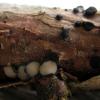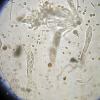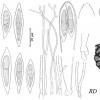
08-04-2010 12:29
Marja PennanenHello I though I was picking some Tympanis and

07-04-2010 02:47
Roland LabbéBonjour à vous tous ! Voici un disco qui nous

01-04-2010 20:30
M. M. GotinkGood evening, I found this Podospora/Schizotheciu

01-04-2010 18:23
Alain BRISSARDBonsoir à tous Nombreux mini-ascomes (0,5-1,5 mm

31-03-2010 03:38
Roland LabbéBonjour ! Voici un disco, probablement un Wilco

30-03-2010 09:59
VASILEIOS KAOUNASIt was found in houmos, searching for ipogei fungh

30-03-2010 03:16
Milanka TanaskovicBonjour à tous, Est-ce-que quelques-uns parmi vo

28-03-2010 18:43
 Nicolas VAN VOOREN
Nicolas VAN VOOREN
Il reste des places pour la session Ascomycètes,
Rhytismatales on Picea
Marja Pennanen,
08-04-2010 12:29
I though I was picking some Tympanis and put the specimen aside in a plastic bag and forgot it there for a week. Now when I had time I decided to try to determine it. I got supriced, because it had opened and looked like Coccomyces. It wasn't and seems to represent a genus unfamiliar to me.
The spores seems to have or not to have a cover and are about 25-35x 10-15 with cover and about 25x3-8 without. Asci about 150-250x20-25 micrometers.
The fruitbodies are 1-2 mm wide.
Marja Pennanen,
08-04-2010 12:32
Kutorga Ernestas,
08-04-2010 12:51
Re:Rhytismatales on Picea
Hello Marja,
it could be Tryblidiopsis pinastri.
Ernestas
it could be Tryblidiopsis pinastri.
Ernestas
René Dougoud,
08-04-2010 13:16
Re:Rhytismatales on Picea
Cher Collègue,
Il s'agit bien, comme l'indique Ernestas, de Tryblidiopsis pinastri (Pers.: Fr.) Karsten
Bubliographie:
BARKLUND, P. & T. KOWALSKI, 1996. Endophytic fungi in branches of Norway spruce
with particular reference to Triblidiopsis pinastri. - Can. J. Bot. 74 : 673-678
DOUGOUD, R. 2000. Le champignon du mois: Tryblidiopsis pinastri. - Bull. Suisse de mycol. / SZP 1: 23-29
LIVSEY, S. & D.W. MINTER., 1994. The taxonomy and biology of Triblidiopsis pinatris.
— Can. J. Bot. 72 : 549-557
REHM, H., 1896. Ascomyceten : Hysteriaceen und Discomyceten. Rabenh. Kryptog. 1(3) :1-
1275
VELENOVSKY, J. 1934. Monographia Discomycetum Bohemiae 1, 2. Prague, 436 pp. (+ 31
planches)
Cordialement
René
Il s'agit bien, comme l'indique Ernestas, de Tryblidiopsis pinastri (Pers.: Fr.) Karsten
Bubliographie:
BARKLUND, P. & T. KOWALSKI, 1996. Endophytic fungi in branches of Norway spruce
with particular reference to Triblidiopsis pinastri. - Can. J. Bot. 74 : 673-678
DOUGOUD, R. 2000. Le champignon du mois: Tryblidiopsis pinastri. - Bull. Suisse de mycol. / SZP 1: 23-29
LIVSEY, S. & D.W. MINTER., 1994. The taxonomy and biology of Triblidiopsis pinatris.
— Can. J. Bot. 72 : 549-557
REHM, H., 1896. Ascomyceten : Hysteriaceen und Discomyceten. Rabenh. Kryptog. 1(3) :1-
1275
VELENOVSKY, J. 1934. Monographia Discomycetum Bohemiae 1, 2. Prague, 436 pp. (+ 31
planches)
Cordialement
René
René Dougoud,
08-04-2010 13:30
Re:Rhytismatales on Picea
Dans l'espoir que le document passe, voici le brouillon de l'article paru dans le Bull. Suisse en 2000
René
René
Christian Lechat,
08-04-2010 13:37

Re:Rhytismatales on Picea
Bonjour René,
votre image ne passe pas, trop lourde ou trop grande.
Essayez de la mettre dans la rubrique "Document" ci-dessous en format PDF.
Si ça ne fonctionne pas, envoyez-moi votre image et je la mettrai en ligne.
Cordialement,
Christian.
votre image ne passe pas, trop lourde ou trop grande.
Essayez de la mettre dans la rubrique "Document" ci-dessous en format PDF.
Si ça ne fonctionne pas, envoyez-moi votre image et je la mettrai en ligne.
Cordialement,
Christian.
Marja Pennanen,
08-04-2010 17:54
Re:Rhytismatales on Picea
Thanks for quick answer.
Merci.
Marja
Merci.
Marja





 11028.pdf
11028.pdf